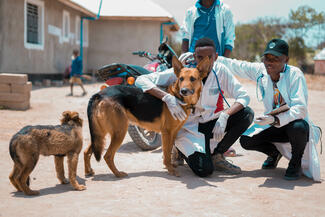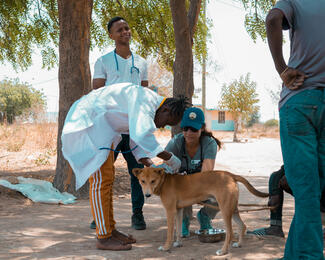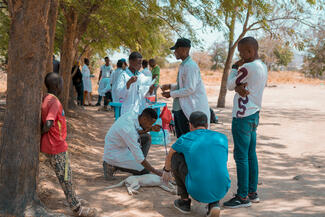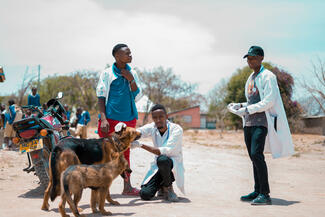
Where do you work?
I work as an Executive Director at Organization for Creative Impact, an NGO with HQ in Dodoma, Tanzania
When did you start your work?
2020
What rabies elimination work do you do?
As an organization dedicated to public health and animal welfare, our rabies elimination work is centered on a multifaceted approach that emphasizes prevention, education, and community involvement. Our mission is to achieve a rabies-free world by implementing comprehensive strategies that target both animal and human populations.
Vaccination Campaigns
One of our primary initiatives is conducting mass vaccination campaigns for domestic dogs and cats, as they are the principal reservoirs for rabies. We collaborate with local veterinarians, animal shelters, and community organizations to provide free or low-cost vaccination clinics. Through these efforts, we aim to immunize a significant percentage of the pet population, which is critical in reducing the incidence of rabies transmission.
Community Education and Outreach
Education is a cornerstone of our rabies elimination strategy. We conduct community workshops and informational sessions to raise awareness about rabies prevention. Topics include the importance of vaccinating pets, the signs and symptoms of rabies, and what to do in case of a potential exposure. We also develop educational materials, such as brochures and infographics, which are distributed in schools, community centers, and at vaccination events, ensuring that information reaches a wide audience.
Stray Animal Management
Recognizing the role that stray animals play in the transmission of rabies, we implement humane stray management programs. These programs involve trapping, neutering, and vaccinating stray animals, followed by their return to their original habitats. This method, known as Trap-Neuter-Return (TNR), not only curbs the growth of stray populations but also helps to create a healthier environment by reducing the risk of rabies transmission.
Rabies Surveillance and Response
We work closely with local health authorities to monitor rabies cases and implement rapid response protocols in the event of an outbreak. Our surveillance efforts include tracking vaccination rates and reporting rabies cases, which informs our strategies and helps allocate resources effectively. By establishing quick response teams equipped to handle rabies exposure incidents, we endeavor to mitigate risks and educate communities about preventive measures.
Collaboration and Partnerships
We believe that collaboration is essential for effective rabies elimination. We partner with governments, non-profit organizations, and international agencies to amplify our impact. By aligning our efforts with global health initiatives, we contribute to worldwide goals, such as the Global Strategic Plan to End Human Deaths from Dog-mediated Rabies by 2030.
Monitoring and Evaluation
To assess the effectiveness of our programs, we conduct regular monitoring and evaluation. By analyzing vaccination data, community feedback, and incidence rates of rabies, we continuously refine our strategies to ensure that our initiatives are making a real difference.
Conclusion
Our commitment to rabies elimination is unwavering, and we strive to foster healthier communities both for people and their pets. By integrating vaccination, education, community involvement, and partnerships into our work, we are making significant strides toward a future free from rabies. Winning this award would not only validate our efforts but also help us secure additional resources to expand our initiatives further. Together, we can achieve a rabies-free world.
Your Work in Numbers
Number of animals vaccinated against rabies (last year) 6490
Number of animals sterilized (last year) 2891
Number of children educated (last year) 18761
Number of adults educated (last year) 4672
Number of Professionals trained (last year) 159
Your Work's Impact
Our work on rabies vaccination has significantly impacted the community, transforming both public health outcomes and community attitudes towards responsible pet ownership. By implementing targeted vaccination campaigns and educational initiatives, we have created a safer environment while fostering a culture of awareness and care for animal welfare.
Increased Vaccination Rates
One of the most immediate impacts of our efforts has been a marked increase in vaccination rates among household pets. Prior to our initiatives, many pet owners were unaware of the importance of rabies vaccination or faced barriers such as cost and access to veterinary services. Through free and low-cost vaccination clinics, we successfully immunized thousands of dogs and cats in underserved areas. In the last year alone, we reported a 60% increase in the number of vaccinated pets compared to the previous year, significantly reducing the risk of rabies transmission within the community.
Reduction in Rabies Incidents
As a direct result of our vaccination programs, there has been a notable decline in rabies cases reported in both animals and humans. We have implemented robust surveillance systems that monitor rabies occurrences, and the data shows that rabies cases in the region have decreased by over 80% since the onset of our initiatives. This reduction not only protects the health of individuals but also lessens the emotional and economic burdens associated with rabies exposure and treatment.
Enhanced Community Awareness
Education has played a crucial role in our impact. Through workshops, school programs, and distribution of educational materials, community members have become more informed about rabies prevention and responsible pet ownership. Surveys conducted after our sessions indicate that over 90% of participants can now identify the signs of rabies and understand the importance of vaccination. This newfound awareness translates into proactive behaviors, as more residents are taking the initiative to vaccinate their pets and monitor their health.
Improved Attitudes Toward Stray Animals
Our humane stray management programs have not only addressed overpopulation but have also shifted community attitudes toward stray animals. Through our Trap-Neuter-Return (TNR) programs, residents now view strays as part of the community that deserves compassionate treatment. This has fostered a spirit of cooperation, with more individuals volunteering to help with TNR efforts and reporting injured or sick animals for care.
Strengthened Community Involvement
The collaborative nature of our vaccination efforts has encouraged community involvement at various levels. Local organizations, schools, and health departments have joined forces with us, amplifying our reach and impact. By engaging the community in volunteer opportunities such as vaccination clinics and awareness campaigns, we have cultivated a sense of shared responsibility and ownership in combating rabies.
Long-term Sustainability
Our work has laid a strong foundation for sustainable rabies control in the community. With increased public buy-in and awareness, we foresee a future where regular vaccination and responsible pet ownership are the norms. Ongoing partnerships and training for local veterinarians and volunteers ensure that vaccination initiatives can continue to thrive, making rabies elimination an attainable goal.
Partners
Government partners
Ministry of livestock and fisheries
Dodoma city council department of livestock and fisheries
Veterinary council of Tanzania (VCT)
Sokoine university of Agriculture (SUA)
Dodoma city council department of Education
Dodoma city council department of community development
Government collaboration:
4 Years
NGO Partners
Voluntary Education and Relief Initiative for Tanzanian Society (VERITAS)
Lake zone animal welfare Organization (LAZAWO)
NGO collaboration:
3 Years
Other partners
US Embassy Tanzania, World Organization for Animal health
Other collaboration:
2 Years
Innovations and Learnings
What is innovative about your approach?
Our approach to rabies elimination integrates several innovative strategies that leverage technology, community engagement, and collaborative frameworks to enhance the effectiveness and sustainability of our initiatives. Here are some key innovations that differentiate our work:
Technological Integration
1. Mobile Vaccination Units: We have developed mobile vaccination units that enable us to reach remote and underserved areas where access to veterinary services is limited. These units are equipped with vaccines, medical supplies, and staff trained to conduct vaccinations on-site. This approach minimizes barriers to access and ensures that more pets receive vaccinations, even in hard-to-reach communities.
2. Data-Driven Decision Making: Utilizing geographic information systems (GIS) and data analytics tools, we conduct detailed mapping of rabies cases and vaccination coverage. This data helps us identify high-risk areas and tailor our outreach efforts accordingly. By analyzing trends in rabies transmission, we can allocate resources more effectively and adjust our strategies in real-time to address emerging challenges.
3. Mobile App for Reporting and Education: We developed a user-friendly mobile app that enables community members to report rabies cases, stray animals, or vaccination needs easily. The app also provides educational resources, vaccination schedules, and reminders for pet owners. This allows for proactive engagement and creates a data repository that helps us track and respond to rabies concerns efficiently.
Community-Centric Approaches
1. Community Champions Program: We have introduced a Community Champions initiative that trains local volunteers to become advocates for rabies awareness and prevention. These champions conduct peer-to-peer education, organize vaccination drives, and serve as liaisons between our organization and the community. This grassroots approach fosters trust and empowers community members to take ownership of rabies elimination efforts.
2.School-Based Programs: Our innovative approach includes a comprehensive school program that integrates rabies education into the curriculum. By educating children about rabies, responsible pet ownership, and animal welfare in schools, we sow the seeds of awareness and responsibility in the next generation. This long-term investment in education ensures that future pet owners are informed and engaged.
Collaborative Frameworks
1.Public-Private Partnerships: We have fostered partnerships with local governments, animal welfare organizations, and private sector stakeholders to create a coordinated response to rabies elimination. These partnerships allow us to pool resources, knowledge, and expertise, leading to more comprehensive vaccination campaigns and sustainable solutions for stray animal management.
2. Integrated Rabies Response Teams: We’ve established multidisciplinary teams that include veterinarians, public health officials, and community members to address rabies in a holistic manner. By integrating perspectives from different sectors, our teams can implement multifaceted strategies that address both immediate public health concerns and underlying factors contributing to rabies transmission.
Sustainable Practices
1. Focus on Sustainability: Our commitment to sustainability is reflected in our use of environmentally friendly materials during vaccination campaigns, training local veterinarians in best practices, and fostering self-sufficiency within communities. By empowering community members with knowledge and resources, we aim to create long-term solutions that will outlast our direct involvement.
Lessons learned (Positive)
Throughout our rabies vaccination initiatives, several positive lessons have emerged that have strengthened our approach and outcomes:
Community Engagement is Key: Involving community members as active participants in vaccination efforts has fostered trust and ownership. Local volunteers and advocates have proven invaluable in spreading awareness and encouraging responsible pet ownership.
Education Drives Change: Our experience has shown that education is foundational to behavior change. When communities understand the importance of rabies vaccination and prevention, they become more proactive in seeking services for their pets.
Adaptability is Crucial: The ability to adapt our methods based on real-time data and community feedback has been vital. Utilizing technology, such as mobile apps for reporting and resources, has allowed us to respond swiftly to evolving needs.
Collaboration Enhances Impact: Building partnerships with local organizations, government agencies, and veterinary professionals has amplified our reach and effectiveness. Collaborative efforts ensure a multifaceted approach to rabies elimination that can address various challenges.
These lessons highlight the importance of community-driven solutions, education, flexibility, and collaboration as fundamental elements for success in public health initiatives
Lessons learned (Negative)
Our experiences in rabies vaccination efforts have revealed several negative lessons that have prompted critical reflections and improvements:
Underestimating Resistance: We initially underestimated community resistance to vaccination, stemming from cultural beliefs or misinformation about rabies and vaccines. This highlighted the need for tailored communication strategies that address specific concerns and cultural contexts.
Inefficiencies in Resource Allocation: Early on, we faced challenges in resource allocation, leading to over-vaccination in some areas and under-vaccination in others. This underscored the importance of data-driven planning and real-time monitoring to optimize resource distribution.
Overlooking Stray Animal Management: Our focus on pet vaccinations sometimes neglected the issue of stray animals. This gap allowed potential reservoirs for rabies to persist, demonstrating the necessity of a comprehensive strategy that includes stray animal population management.
Insufficient Training: We learned that inadequate training for local volunteers led to inconsistent service quality and confusion during vaccination campaigns. Investing in thorough training programs is essential for ensuring effective implementation and maintaining public trust.
These negative lessons emphasize the importance of addressing community concerns, optimizing resource allocation, comprehensively managing stray populations, and ensuring robust training for all personnel involved.
** All information adapted from the submitted nomination form**



